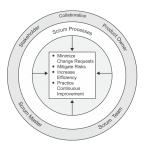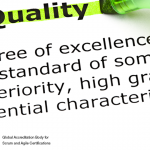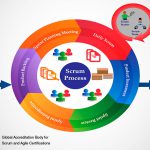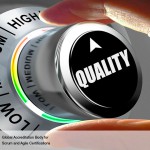The Agile Manifesto stresses “customer collaboration over contract negotiation.” The Scrum framework adopts an approach in which the Scrum Core Team members collaborate with each other and the stakeholders to create the deliverables that provide the greatest possible value to the customer.
According to A Guide to the Scrum Body of Knowledge (SBOK™), collaboration ensures that companies realize the following project benefits:
- Minimize changes resulting from poorly clarified requirements. During the Create Project Vision, Develop Epic(s) and Create Prioritized Product Backlog processes, the Product Owner collaborates with stakeholders to create the Project Vision, Epics and Prioritized Product Backlog, respectively. This will ensure that there is clarity among Scrum Core Team members about the work that is required. The Groom Prioritized Product Backlog and Review and Demonstrate Deliverables processes provide scheduled times for the Scrum Core Team members to discuss what has been done and collaborate with stakeholders on what needs to be done. Through these efforts, the number of Change Requests from the customer and rework is minimized.
- Efficiently identify and deal with risks. Risks to the project are identified and assessed in the Develop Epic(s), Create Deliverables and Conduct Daily Standup processes by the Scrum Core Team members. The Scrum meeting tools such as the Daily Standup Meeting, Sprint Planning Meeting, Prioritized Product Backlog Review Meeting and more provide opportunities to the team to not only identify and assess risks but also implement the right risk responses at the times they are needed most.
- Realize the true potential of the team. According to the SBOK™, the Conduct Daily Standup process provides time each day for the Scrum Team to collaborate and understand the strengths and weaknesses of its members. If a team member has missed a task deadline, the Scrum Team members align themselves collaboratively to complete the task and meet the agreed upon targets for completing the Sprint.
- Ensure continuous improvement through lessons learned. The Scrum Team uses the Retrospect Sprint process to identify what went well and what did not go well in the previous Sprint. This provides an opportunity to the Scrum Master to work with the team to rework and improve the team and processes for the next scheduled Sprint. This will also ensure that collaboration is even more effective in the next Sprint.
For companies that wish to minimize setbacks, maximize efficiency and realize the full potential of their workforce, SCRUMstudy and its 500+ Authorized Training Partners offer not only the opportunity but also the framework and guidance to get it done.
For interesting articles about Scrum and Agile, visit www.scrumstudy.com/blog










